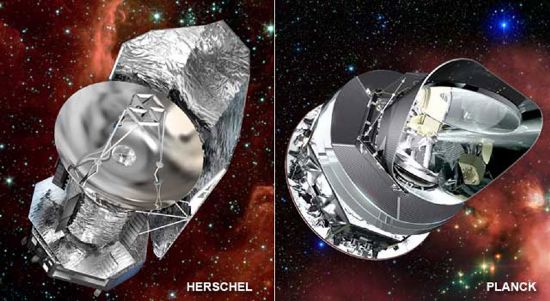Seeing Stars - Inverness Courier, Fri 3rd July 2009
Seeking Out Landing Sites
By Pauline Macrae - Highlands Astronomical Society
Two double launches have taken place over the last couple of months. First to lift off were the Planck observatory and the Herschel observatory, both on board the Ariane rocket. This is a European Space Agency mission with NASA participation.
The Planck observatory will study the cosmic microwave background radiation, which is considered to be the first light from the young universe, after it had cooled to the point where matter and light were able to exist independently from one another – about 380,000 years after the Big Bang.
By measuring tiny fluctuations in the cosmic microwave background radiation across the entire sky it will provide the clearest picture of the universe yet. These variations are about a millionth of the average level of microwave background temperature, giving sensitivity far above that of the previous two missions. Planck should improve the scientists’ understanding of ‘dark energy’ and also help test the theory of inflation, which states that the universe underwent a rapid expansion in a fraction of a second after the Big Bang.
 |
| Herschel & Planck observatories. Image courtesy JPL/NASA. |
The Herschel observatory is the world’s most advanced infrared telescope and will help scientists learn how new stars are formed and how galaxies evolve over billions of years. It is the biggest spacecraft ever launched, at nearly 25 feet tall and 15 feet across, and has been 20 years in the making.
This telescope will look into far infrared radiation never studied before. Sensors will be able to peer through dust clouds and deep into star-forming regions across our own Galaxy and others too, allowing astronomers to see the very start of star formation; i.e. stars that haven’t even been born yet.
The first stars making up the earliest galaxies are often massive and move through their life cycles quickly before exploding as supernovae. Because they produce so much energy they tend to dominate these young galaxies and should therefore be easily spotted by Herschel. In addition, Herschel will also help astronomers create highly detailed chemical maps of objects in the solar system.
Both Observatories will use liquid helium to cool their instruments to very low temperatures. This will allow Planck to sense the warmth from the cosmic microwave background radiation, which has a temperature of just under 3 k, and for Herschel to see the faint emissions of cold objects in the distant reaches of the universe.
They will be placed in the second Lagrange point (L2), nearly 1 million miles from the night side of the Earth and four times past the orbit of the Moon. L2 is the point where the tug of gravity from the Earth and Sun balance, allowing spacecraft stationed there to stay in step with our planet as it orbits the Sun.
Another dual mission, which blasted off from Cape Canaveral in Florida, consists of two spacecraft heading to the Moon. One will map the surface from an altitude of just 50 km, as it loops around our closest neighbour in a polar orbit. The other will crash into the surface allowing the rock and soil to be chemically analysed.
 |
| Lunar Reconnaissance Orbiter. Image courtesy NASA. |
Equipped with seven high-tech cameras and various other instruments, the Lunar Reconnaissance Orbiter will be able to seek out landing sites for future missions. Its polar orbit means it can search for everything that has ever landed on the Moon thus possibly answering some of the mysteries surrounding some past missions. To this end there is a target list of 50 locations, including all Apollo landing sites, for the cameras to concentrate on. After a year of looking for suitable landing sites, there will be three years of scientific observations.
The accompanying spacecraft is known as the Lunar Crater Observing and Sensing Satellite or LCROSS. Its job is to move the Atlas V rocket’s Centaur second stage into an elongated orbit that will take it around the Earth and then four months later plunge it into the lunar surface at the Moon’s south pole. LCROSS will be following close behind so it can analyse the composition of the debris cloud thrown up by the impact and look, in particular, for signs of water ice. It will also crash into the Moon but not before the Hubble Space Telescope receives its data.
Professional and amateur astronomers will be able to watch the bright flash made by the impact whilst the Hubble Telescope films it.
This NASA mission to the Moon coincides nicely with the 40th anniversary of Apollo 11’s first manned lunar landing which took place on the 20th July 1969. One day it is hoped that people will return to the Moon so these two missions are the first step on the way back. They will provide the data and information required to establish the future lunar bases, and searching for water is vitally important, as it cannot be transported there in large enough quantities for people and exploration needs.
Next time you look up at the Moon, remember that humans have walked upon its surface and may do so again, possibly even within your lifetime. Will one of them be your child or grandchild?